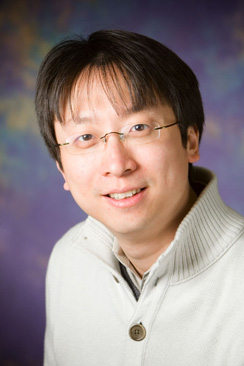Speakers

|
Using Image Processing to Reverse Engineer the Brain

Scott T. Acton
University of Virginia, Charlottesville, Virginia USA
Abstract: A global effort is underway in the twenty-first century to reverse engineer the brain. Scott Acton will highlight image processing and analysis work in neuroscience that is supporting this effort. The scientific community is attempting to map the structure and connectivity of neurons in organisms such as Drosophila – the fruit fly. To accomplish such an atlas, automated image analysis is required and stands as a major roadblock to success. The talk addresses recent progress in the segmentation and tracing of individual neurons. Graph theoretic and diffusion-based methods are discussed along with results. Furthermore, the comparison and matching of neurons is described. Extensions of this work include the mapping the recently discovered meningeal lymphatic system in the brain as well as using image analysis to unravel mysteries of the glia.
Biography
Scott T. Acton is Professor of Electrical & Computer Engineering and of Biomedical Engineering at the University of Virginia. He received his M.S. and Ph.D. degrees at the University of Texas at Austin. He received his B.S. degree at Virginia Tech. He is a Fellow of the IEEE.
Professor Acton’s laboratory at UVA is called VIVA - Virginia Image and Video Analysis. They specialize in biomedical image analysis problems. The research emphasis of VIVA is video tracking and segmentation. Professor Acton has over 275 publications in the image analysis area including the books Biomedical Image Analysis: Tracking and Biomedical Image Analysis: Segmentation. Professor Acton has been at the University of Virginia since 2000. Before that time, he worked in the academic world for Oklahoma State University and in the engineering world for AT&T, Motorola and the Mitre Corporation. He is editor-in-chief of the IEEE Transactions on Image Processing.
Giving VR/AR Eyes and Brain

Jingyi Yu
School of Information Science and Technology , ShanghaiTech University, China
Abstract: The real world presents extremely high-dimensional data: it composes of geometry, lighting, surface reflectance, etc. The human visual system relies on a variety of cues to perceive these properties where the most important ones are binocular, defocus, and motion cues. Faithful reproduction of these cues is essential for producing immersive virtual and augmented reality experiences. In this talk, Ivfirst present the latest technologies from my group and my colleagues that employ light fields to give V/AR "eyes". On the acquisition front, I introduce the latest light field capture solutions for producing ultra-realistic environments. On the processing front, I show how to exploit ray geometric structures and sampling patterns of light fields for reliable 3D reconstruction, dynamic refocusing, and interaction. On the display front, I show how light field head-mounted displays (LF-HMD) can provide unprecedented refocusing capability analogous to the human eyes to significantly enhance visual realism. Finally, I will present our latest approaches that employ deep learning techniques on light fields to accelerate modeling and rendering solutions as well as improve their accuracy, i.e., to ultimately give V/AR both eyes and brain.
Biography: Jingyi Yu is a Professor at the School of Information Science and Technology at the ShanghaiTech University and a Professor in the Department of Computer and Information Sciences at the University of Delaware. He is also the founding director of the Virtual Reality and Visual Computing Center at ShanghaiTech. Yu received B.S. from Caltech in 2000 and Ph.D. from MIT in 2005. His research interests span a range of areas in computer vision, computational photography and computer graphics and he is a recipient of the NSF CAREER Award and the AFOSR YIP Award. He is also the program chair of the 2021 IEEE Conference on Computer Vision and Pattern Recognition (CVPR), the most influential conference in computer vision and artificial intelligence. Previously he served as a Program Chair of ICCP 2016 and an Area Chair of ICCV '11,'15, '17, CVPR '17, and NIPS '15, '17. He also serves as an Associate Editor of IEEE TPAMI, Elsevier CVIU, Springer TVCJ and Springer MVA. In 2015, he founded Plex VR, a startup company that focuses on light field based imaging and display technologies.
Mapping the World with Drones!

Professor Long QUAN
Department of Computer Science and Engineering
Abstract:
Professor Quan leads a computer vision team that uses photographs and deep visual learning technologies to produce complete 3D reconstruction of all types of locations and objects on Earth. In this talk, he reviews the developments in computer vision and machine learning over the past two decades. He also turns the focus on recent exciting work in deep visual learning and large-scale 3D reconstruction using drone photographs. Here, he showcases the approach using case studies of hundreds of square kilometers in both high-rise metropolitan areas and undeveloped rural areas in a variety of different countries. He also demonstrates the online cloud platform and portal www.altizure.com with its crowed-sourced Altizure Earth, developed and funded by the HKUST team, rivaling the popular Google earth!
Biography:
Long QUAN is a Professor of the Department of Computer Science and Engineering at HKUST. He received his PhD in 1989 in Computer Science from INPL, France. He became a permanent researcher at CNRS in 1990 and was appointed to INRIA in Grenoble, France. He joined HKUST in 2001, and was the founding director of the HKUST Center for Visual Computing and Image Science. He is a Fellow of the IEEE Computer Society. He founded the altizure.com.
He works on vision geometry, 3D reconstruction and image-based modeling. He was voted one of the HKUST Best Ten Lecturers in 2004 and 2009. He has served as an Associate Editor of IEEE Transactions on Pattern Analysis and Machine Intelligence, and is a Regional Editor of Image and Vision Computing Journal. He is on the editorial board of the International Journal of Computer Vision, Electronic Letters on Computer Vision and Image Analysis, Machine Vision and Applications, and Foundations and Trends in Computer Graphics and Vision. He was a Program Chair of IAPR International Conference on Pattern Recognition 2006 Computer Vision and Image Analysis, a Program Chair of ICPR 2012 Computer and Robot Vision, and a General Chair of IEEE International Conference on Computer Vision (ICCV) 2011.
Low-dimensional Structures and Deep Models for
High-dimensional (Visual) Data

Yi Ma
School of Information Sciences and Technology, ShanghaiTech University, China
Abstract:
In this talk, we will discuss a class of models and techniques that can effectively model and extract rich low-dimensional structures in high-dimensional data such as images and videos, despite nonlinear transformation, gross corruption, or severely compressed measurements. This work leverages recent advancements in convex optimization from Compressive Sensing for recovering low-rank or sparse signals that provide both strong theoretical guarantees and efficient and scalable algorithms for solving such high-dimensional combinatorial problems. We illustrate how these new mathematical models and tools could bring disruptive changes to solutions to many challenging tasks in computer vision, image processing, and pattern recognition. We will also illustrate some emerging applications of these tools to other data types such as 3D range data, web documents, image tags, bioinformatics data, audio/music analysis, etc. Throughout the talk, we will discuss strong connections of algorithms from Compressive Sensing with other popular data-driven models such as Deep Neural Networks, providing some new perspectives to understand Deep Learning.
This is joint work with John Wright of Columbia, Emmanuel Candes of Stanford, Zhouchen Lin of Peking University, Shenghua Gao of ShanghaiTech, and my former students Zhengdong Zhang, Xiao Liang of Tsinghua University, Arvind Ganesh, Zihan Zhou, Kerui Min of UIUC etc.
Brief Biography:
Yi Ma has been a Professor and the Executive Dean of the School of Information and Science and Technology, ShanghaiTech University, China from 2014 to 2017. From 2009 to early 2014, he was a Principal Researcher and the Research Manager of the Visual Computing group at Microsoft Research in Beijing. From 2000 to 2011, he was an Associate Professor at the Electrical & Computer Engineering Department of the University of Illinois at Urbana-Champaign. His main research interest is in computer vision, high-dimensional data analysis, and systems theory. He has written two textbooks “An Invitation to 3-D Vision” published by Springer in 2004, and “Generalized Principal Component Analysis” published by Springer in 2016. Yi Ma received his Bachelors’ degree in Automation and Applied Mathematics from Tsinghua University (Beijing, China) in 1995, a Master of Science degree in EECS in 1997, a Master of Arts degree in Mathematics in 2000, and a PhD degree in EECS in 2000, all from the University of California at Berkeley. Yi Ma received the David Marr Best Paper Prize at the International Conference on Computer Vision 1999, the Longuet-Higgins Best Paper Prize (honorable mention) at the European Conference on Computer Vision 2004, and the Sang Uk Lee Best Student Paper Award with his students at the Asian Conference on Computer Vision in 2009. He also received the CAREER Award from the National Science Foundation in 2004 and the Young Investigator Award from the Office of Naval Research in 2005. He was an associate editor of IEEE Transactions on Pattern Analysis and Machine Intelligence (PAMI), the International Journal of Computer Vision (IJCV), and IEEE transactions on Information Theory. He is currently an associate editor of the IMA journal on Information and Inference, SIAM journal on Imaging Sciences, IEEE Signal Processing Magazine. He served as a Program Chair for ICCV 2013 and is a General Chair for ICCV 2015. He is a Fellow of IEEE. He is ranked the World's Highly Cited Researchers of 2016 by Clarivate Analytics of Thomson Reuters and is among Top 50 of the Most Influential Authors in Computer Science of the World, ranked by Semantic Scholar, reported by Science Magazine, April 2016.
|









 京公网安备 11010802035654号
京ICP备12009057号-2
京公网安备 11010802035654号
京ICP备12009057号-2